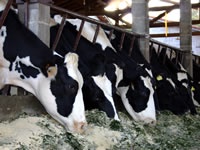Yeast as a feed additive that improves health and productivity in cattle

Yeast cultures mopped up oxygen in the animal's stomach. As the process of fermentation, which is important in cattle digestion, only occurs in the absence of oxygen, the yeasts served a useful purpose. The removal of oxygen leads to a cascade of positive effects on digestion that, in turn, benefit animal health and productivity.
This seminal discovery transformed confidence among the livestock industry in the benefits of yeast as a feed additive. The benefits are enormous. For example, a recent study indicated that a benefit of yeast was an increased milk production of 1.16 kg/cow/day, or 423 kg/cow/yr.
The use of live yeast in livestock production increased enormously as a result, such that the great majority of cattle in North America, and millions of cattle in Europe, now receive live yeast as a food additive (Levucell) routinely as a feed additive.
We have demonstrated why yeast cultures are beneficial for farm livestock production. Yeast's ability to take up oxygen is what does the trick
Professor John Wallace
Find out more
Key publications
- Newbold, CJ, R.J. Wallace, X.B. Chen, and F.M. McIntosh. (1995). Different strains of Saccharomyces cerevisiae differ in their effects on ruminal bacterial numbers in vitro and in sheep. J. Anim. Sci. 73:1811-1818.
- Newbold, CJ, RJ Wallace, and FM McIntosh. (1996). Mode of action of the yeast Saccharomyces cerevisiae as a feed additive for ruminants. Br. J. Nutr. 76:249-261.
